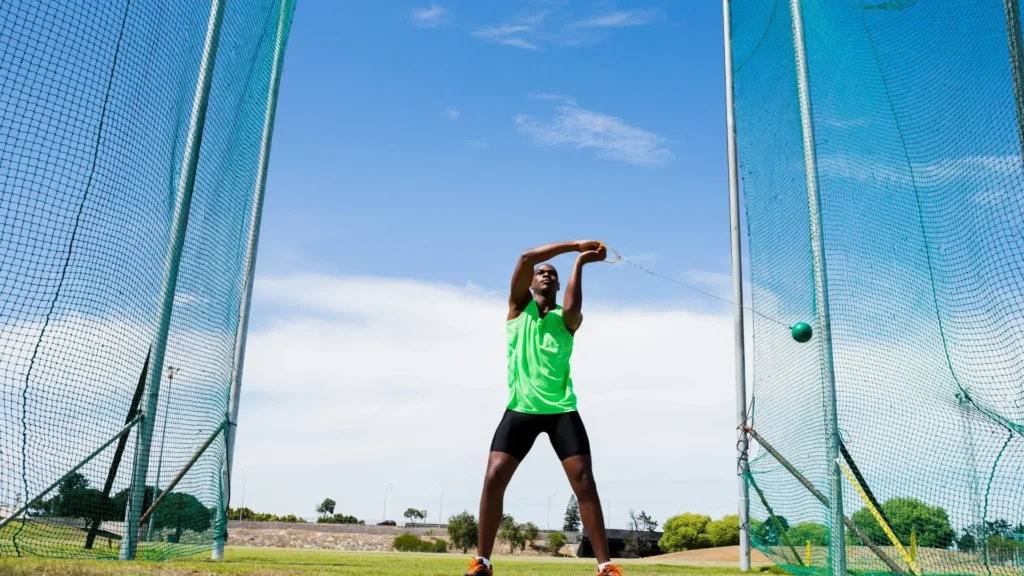
Hey, sports enthusiasts! Today we’re talking about stimulus discrimination and how can this help you take your training to the next level!
Ever wondered why some athletes seem to nail their performance under pressure, while others falter despite having similar skills?
Well, a big part of that puzzle might just be something called stimulus discrimination.
Let’s dive into what this is and how you can use it to up your game.
What is Stimulus Discrimination?
Stimulus discrimination is a fancy term used in psychology, but don’t let it scare you.
It’s all about recognizing and responding differently to various stimuli or situations.
For an athlete, this means distinguishing between different game scenarios, crowd noises, or even the pressure of competition.
It’s the skill that helps you react correctly to what’s happening right now, not mixing it up with other experiences.
At its core, stimulus discrimination is about making fine distinctions.
It’s about your brain recognizing, processing, and acting on the differences between similar stimuli.
For example, in tennis, it’s about distinguishing between a fast serve and a slice serve as they come toward you, allowing you to make the appropriate return.
Another aspect of stimulus discrimination is learning to ignore irrelevant stimuli.
This means not just recognizing different scenarios but also knowing which elements in an environment to focus on and which to disregard.
For a soccer player, this could mean focusing on the movement of the ball and nearby players while tuning out the crowd and other background noise.
Moreover, stimulus discrimination isn’t just physical. It’s also emotional!
Athletes must learn to discriminate between nerves that can fuel a performance and anxiety that may hinder it.
This emotional discrimination helps athletes manage their feelings effectively, ensuring they perform their best when it counts.
In practice, developing strong stimulus discrimination can involve exercises that specifically target sensory and perceptual skills.
For instance, drills that require athletes to respond to specific auditory signals amidst a range of background noises can enhance their ability to focus under varied sensory conditions.
By sharpening these skills, athletes enhance their ability to make split-second decisions that are crucial during high-stakes moments in sports.
This kind of precision in responding appropriately to different stimuli directly influences an athlete’s performance and can be the key to mastering their sport.
Why is it Important to Know About Stimulus Discrimination?
Understanding stimulus discrimination is crucial because it helps athletes stay focused and effective.
It can be the difference between scoring that goal in a noisy stadium versus getting distracted and missing a shot.
By mastering this skill, athletes can enhance their ability to perform consistently, no matter the environment.
Getting a grip on stimulus discrimination doesn’t just boost performance on the field.
It has broader implications for training efficiency and mental resilience.
Stimulus discrimination speeds up the learning process.
Athletes who can quickly distinguish between different types of pitches, court positions, or opponent strategies can adapt their techniques on the fly.
This adaptability is essential for both short-term performance and long-term development.
Overgeneralization is when an athlete’s response is the same to different stimuli, which might not always be beneficial.
For example, a boxer throwing the same kind of punch regardless of the opponent’s stance might not be effective.
Understanding and practicing stimulus discrimination helps prevent this, ensuring athletes respond most appropriately to the specifics of the situation.
Knowing about stimulus discrimination helps athletes develop sharper focus.
It trains them to hone in on what’s important in a chaotic environment.
This could mean filtering out crowd noise to focus on the coach’s instructions or ignoring irrelevant actions of an opponent to focus on their pivotal movements.
Athletes often face high-pressure situations where stress and anxiety can impair performance.
Effective stimulus discrimination helps in identifying stress triggers and managing responses to them.
This means athletes can maintain composure and execute skills proficiently under pressure.
In high-speed and contact sports, quick and accurate response to stimuli can mean the difference between a successful play and an injury.
Being able to discriminate between a safe opportunity to tackle and a risky one can protect athletes from unnecessary harm.
By enhancing their understanding of stimulus discrimination, athletes not only improve their performance but also contribute to a more disciplined, safer, and psychologically sound approach to their sport.
This knowledge empowers them to face various competition scenarios with confidence and a clearer strategy.
Examples of How to Deal with Stimulus Discrimination
So, how do we handle stimulus discrimination?
Here are some specific ways to deal with stimulus discrimination in a productive way
- Drill Variation
One effective way to enhance stimulus discrimination is by varying drills in practice sessions.
For instance, a volleyball coach might use different colored balls in drills, each color signaling a different type of play or strategy.
This helps players react quickly and appropriately in games when split-second decisions are needed.
- Simulated Environments
Creating practice environments that mimic real game situations can be incredibly beneficial.
For instance, a golfer might practice putting with distractions such as noise or wind machines to simulate challenging conditions.
This kind of training enhances an athlete’s ability to discriminate between different environmental stimuli and maintain focus.
- Feedback Loops
Immediate feedback during training is crucial for improving stimulus discrimination.
Coaches can use video replays to point out instances where an athlete reacted well or poorly to specific stimuli.
This helps the athlete recognize successful patterns of discrimination and learn from mistakes.
- Cognitive Training Tools
Technological tools like virtual reality (VR) and video games designed for cognitive development can also aid in improving stimulus discrimination.
These tools can simulate various scenarios that an athlete might not frequently encounter, providing a safe space to practice and learn.
- Group Dynamics
Training with a team can also enhance stimulus discrimination skills.
Team drills that require athletes to respond to cues from teammates can improve their ability to focus on relevant stimuli and ignore distractions.
For example, a basketball drill where only passes from players wearing a particular bibb count encourages players to be more observant and selective in their responses.
- Sensory Training
Athletes can also engage in sensory-specific practices.
For example, racquet sports players can train with slightly modified equipment, like using a ball with an unusual texture or color, to enhance their sensory discrimination skills.
This can improve their reaction times and accuracy in normal play conditions.
Incorporating these methods into regular training routines not only enhances stimulus discrimination but also prepares athletes to manage unexpected or challenging conditions effectively.
This kind of focused training is what ultimately separates top-performing athletes from the rest.
How to Use Stimulus Discrimination to My Advantage When Training?
Leverage stimulus discrimination by making your training as real as it gets.
Mix up your practice environments and scenarios frequently.
This keeps you on your toes and prepares you better for any situation.
Also, focus on mindfulness exercises.
These can improve your awareness and ability to distinguish between different stimuli effectively.
Start with simple discrimination tasks in your training and gradually increase the complexity.
For instance, a soccer player might begin by distinguishing between two whistle sounds for different drills and then progress to respond to complex play calls amid background noise.
This gradual increase in difficulty helps build the neural pathways needed for quick and accurate discrimination under pressure.
Incorporate elements that mimic the specific contexts you will face during actual competitions.
For example, runners can practice starts with varied background noise levels or in different weather conditions to adapt their start response appropriately to the sound of the starting gun, regardless of external distractions.
Applying constraints during practice can enhance stimulus discrimination.
For example, a tennis player could practice hitting only when the ball comes from a particular direction or only when it crosses a specific height.
This not only improves reaction times but also aids in better decision-making during games.
Introduce time constraints in drills to mimic game-speed decisions.
This could involve making split-second decisions about which skill to use or which strategy to apply within a limited time frame.
This type of training helps athletes improve their quick discrimination and execution under game-like pressures.
Develop pre-performance routines that include mental rehearsal of discriminating between different stimuli.
For example, a swimmer might visualize distinguishing the sound of their specific start signal amidst poolside noise.
This mental practice can help solidify the discrimination skills needed when it counts.
Engage in competitive practice scenarios where peers provide unpredictable stimuli.
For instance, in martial arts, sparring with a partner who varies their attack patterns can enhance an athlete’s ability to quickly discriminate between different types of attacks and defend effectively.
By integrating these strategies into your training, you can significantly boost your stimulus discrimination capabilities.
This doesn’t just improve your performance; it also enhances your adaptability, making you a more versatile and resilient athlete in any competitive situation.
Additional Tips to Enhance Stimulus Discrimination
A few extra tips can help boost your ability to discriminate stimuli.
Incorporate cognitive training games that challenge your reaction to different stimuli.
Also, consider working with a sports psychologist who can provide personalized strategies and feedback.
Another key strategy is debriefing after games or training sessions.
Reflect on how well you distinguished between various stimuli and what you might improve next time.
- Specialized Sensory Drills
Focus on drills that isolate and train individual senses.
For example, a baseball player might practice hitting in lower light conditions to improve visual discrimination of the ball under different lighting.
Or a football quarterback might listen to recorded play calls at varying volumes and background noises to sharpen auditory discrimination.
- Cross-Training
Participating in different sports can provide varied stimuli which enhance overall sensory and cognitive agility.
For instance, a basketball player might play soccer to improve footwork and spatial awareness, indirectly benefiting their primary sport by enhancing their ability to discriminate between player movements and game dynamics.
- Biofeedback Techniques
Utilizing biofeedback can help athletes become more aware of their physiological responses to different stimuli and learn to control them better.
For example, heart rate variability (HRV) training can help athletes manage their arousal levels in response to stressful stimuli, improving their overall performance in high-pressure situations.
- Neurofeedback Training
This is a more advanced technique where athletes train to improve brain function based on real-time displays of brain activity.
This can help in enhancing concentration and reducing the cognitive load, allowing for better discrimination between critical and non-critical stimuli during competitions.
- Cue Conditioning
Athletes can develop specific cues that help trigger the right responses during competition.
For example, a cue could be a particular gesture or a self-spoken word that reminds the athlete of the focus needed when multiple stimuli are present.
This method helps in creating automatic responses that are essential during fast-paced sports.
- Recovery Practices
Adequate rest and recovery are vital in maintaining cognitive sharpness necessary for effective stimulus discrimination.
Incorporating mindfulness and meditation into recovery days can help clear mental clutter, enhancing the ability to distinguish relevant from irrelevant stimuli during performance.
By integrating these additional techniques into your training regime, you can not only enhance your ability to discriminate between different stimuli effectively but also improve your overall athletic performance and mental toughness.
Each of these strategies can be tailored to fit the specific demands of your sport and your personal performance goals.
Conclusion
Stimulus discrimination is your secret weapon in sports.
It’s all about training smarter, not just harder.
By mastering the ability to respond accurately to different game scenarios, you’re setting yourself up for the win.
Use the tips and strategies we’ve talked about to sharpen your skills and outplay the competition.
If you’re looking to dive deeper and really push your limits, check out the Success Stories Community.
It’s a space where I help athletes like you level up.
You’ll get personalized support, connect with others who are just as driven, and access loads of resources that boost your performance.
So, what are you waiting for?
Join us at the Success Stories Community and start turning those game-day pressures into opportunities.
Let’s make those training sessions count and see you topping the scoreboard!



